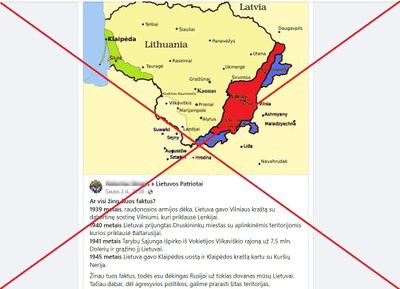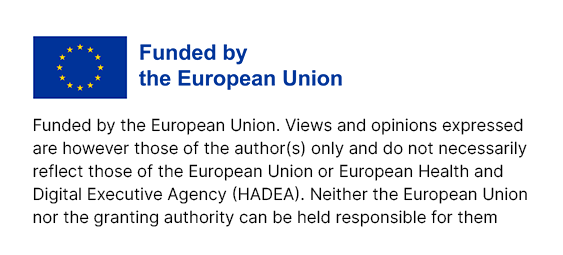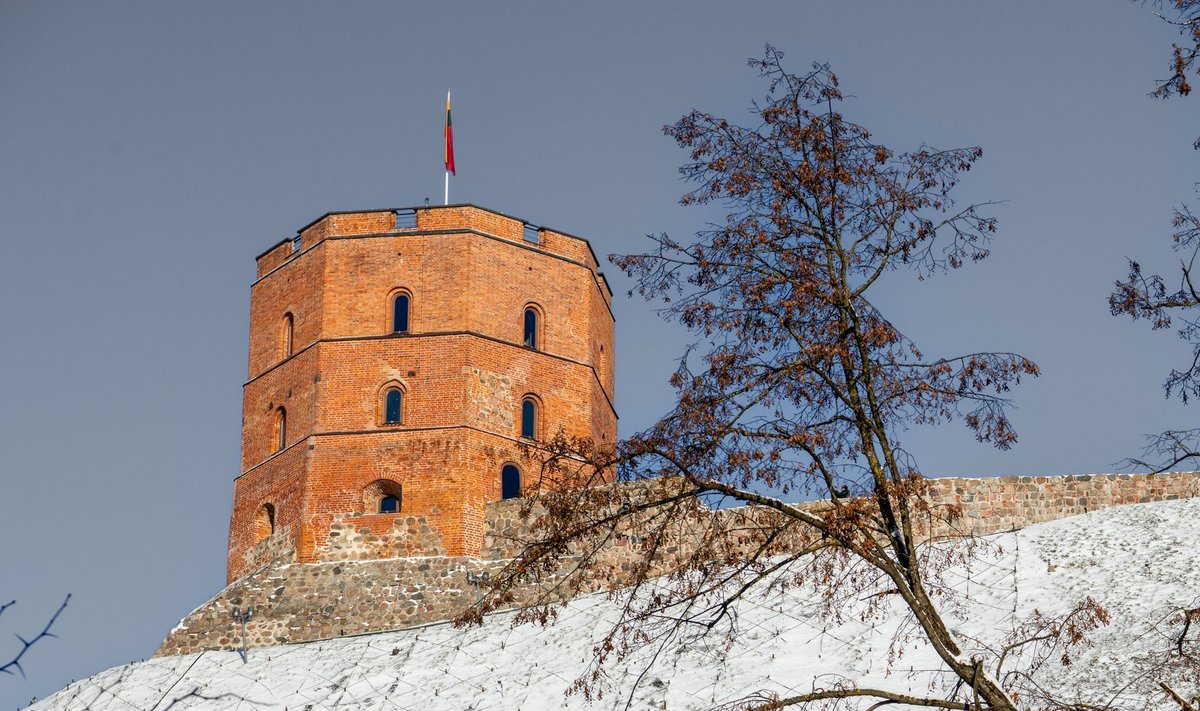CLAIMS
Russia gave Lithuania the Vilnius region, the city of Druskininkai, Vilkaviškis district, the port of Klaipėda, and the Klaipėda region with the Curonian Spit.
VERDICT
It is untrue. Almost all of these territories were annexed by Russia either in preparation for the occupation of Lithuania or after its occupation. Research conducted by the Centre for the Analysis of Disinformation and Misinformation has shown that one of the Kremlin's most prevalent narratives is that Lithuania and other countries expanded their territories with Soviet assistance.
LIE DETECTOR‘S COMMENTARY
Social media shares posts containing false claims that “in 1939, owing to the Red Army, Lithuania acquired the Vilnius region with its current capital Vilnius, which had belonged to Poland; in 1940, Lithuania annexed the city of Druskininkai and its surrounding territories, that previously belonged to Belarus; in 1941, the Soviet Union bought out the Vilkaviškis district from Germany for $7.5 million and returned to Lithuania; and in 1945, Lithuania obtained the Port of Klaipėda and the Klaipėda region, along with the Curonian Spit". Internet users sharing such misleading statements claim that these are historical facts and express "gratitude to Russia for these gifts to Lithuania".

Initially, back in 2020, these alleged facts were presented by one of the Kremlin's most prominent propagandists, Dmitry Kiseliov. In his program "Weekly Review" on Russia's RT television, he asserted that Lithuania only acquired its current territory during Soviet times. According to Kiseliov, Lithuania should be grateful to Russia for Vilnius, Klaipėda, and the Vilkaviškis region (here).
However, it is a false claim that Russia granted Vilnius or any other territories to Lithuania. Russia’s actions were motivated by self-interest and future plans, not benevolence.
The Centre for the Analysis of Disinformation and Misinformation has pointed out that the majority of publications disseminated or initiated by Russia in recent years have focused on the fact that Lithuania should be grateful to the Soviet Union for its liberation. It has also been argued that Lithuania and other countries expanded their territories with Soviet assistance, and without the help of the Red Army, Nazi Germany might has exterminated the population of the Baltic States.
Historians point out that relations between the newly restored Lithuanian state in 1918 and Soviet Russia (which in 1922 became the Union of Soviet Socialist Republics (USSR)) were based on the 1920 Lithuania-Soviet Russia Peace Treaty. The USSR aimed to incorporate the Baltic States into its sphere of influence in the future, thus had interest in Lithuania's independence (here).
Germany pledged not to support any third power against Lithuania but broke the promise by signing a secret treaty with the USSR on August 23, 1939, known as the Molotov-Ribbentrop Pact. This treaty divided Eastern Europe into spheres of influence between Germany and the USSR. Lithuania fell under German influence, while Latvia and Estonia fell under USSR influence. However, under the treaty of September 28, 1939 with Germany, the USSR ceded to Germany the territories east of the Vistula River, and Germany agreed to bring Lithuania, as well as the other two Baltic states, into the USSR's sphere of influence.
Subsequently, Lithuania was coerced into signing the Soviet–Lithuanian Mutual Assistance Treaty, and about 20,000 (later more) USSR troops were stationed on its territory. In return, the USSR allegedly, in accordance with the 1920 peace treaty, ceded Vilnius (with 215,000 inhabitants) and part of the Vilnius region to Lithuania on October 9, 1939, while the remaining was given to Belarus (here).
However, only part of the Vilnius region, 6909 km² with 490,000 inhabitants, was returned to Lithuania – about one fifth. After Lithuania was occupied, on November 6, 1940, an additional 2,637 km² (including Druskininkai, Dieveniškės, Švenčionys) were annexed to Lithuania. The entire Vilnius region returned to Lithuania then covered only 9546 km² with 565,400 inhabitants (here).
Gintautas Šapoka, nephew of the renowned historian Adolfas Šapoka, explained that when a portion of the Vilnius region was returned to Lithuania, the border between Lithuania and the Soviet Union was established on October 28, 1939. The border was drawn in a peculiar manner, excluding such Lithuanian districts as Druskininkai, Marcinkonys, Mielagėnai, Švenčionys, Tverečius and others. Presumably, this was done on purpose, because the Communists gave nothing away for free. They hoped to use the Lithuanians who remained outside Lithuania for the future occupation of Lithuania (here).
As for Russia's alleged “buying out" the Vilkaviškis district from Lithuania, there are no historical records supporting this claim. On the contrary, when the Russians occupied Lithuania on June 15, 1940, they nationalised private institutions, including hospitals, factories, workshops, and bookshops in Vilkaviškis. Vilkaviškis Manor was shut down. Vilkaviškis, as a border town, was heavily occupied by Russian troops. Between June 13 and 15, 1941, 569 people were deported in cattle wagons from Vilkaviškis to Siberia (here).
After the First World War, in June 1919, according to the Versailles Peace Treaty, the Klaipėda region was separated from Germany and temporarily placed under the control of the United Kingdom, France, Italy, and Japan, with the Nemunas River from the town of Grodno to the estuary being internationalised.
However, in November 1921, the Constituent Seimas of the Republic of Lithuania voted for the annexation of the Klaipėda Region. In late 1922, a revolt, supported by the Lithuanian government, erupted. On January 10, 1923, a detachment of about 1,500 insurgents (300 of them were from Klaipėda) entered the territory of the Klaipėda region, regaining control of the city by January 15, 1923.
Since then, Klaipėda and parts of its surrounding territories have been part of Lithuania, but in October 1938, Adolf Hitler signed a secret directive authorising the army to prepare for the occupation of the Klaipėda region. When Nazi Germany occupied the Czech Republic in March 1939, convinced that the Western powers would tolerate such aggression, it issued an ultimatum demanding Lithuania to hand over Klaipėda to Germany immediately. Unable to resist coercion, Lithuania had no other choice but to sign a treaty ceding the land to Germany, and from March 23, 1939 the territory was occupied by German troops.
During the Klaipėda Military Operation in January 1945, the USSR troops captured Klaipėda, and, in February – the Curonian Spit. The Klaipėda region was then annexed to Soviet-occupied Lithuania (here).
To sum up, the USSR was fighting its greatest enemy, Nazi Germany, and Klaipėda was a prize that could logically be given to Lithuania, which was still ruled by Russia.
All these "gifts", except for the Klaipėda region, contributed to the occupation of Lithuania by Russia in 1940, initiating repressions, the Sovietisation of the region, and the tragedy of Black June in 1941 (here).
SOURCES:
- The Molotov–Ribbentrop Pact
- The German-Soviet Treaty of Friendship and Border
- Vilnius region
- Klaipėda region
- Vilkaviškis distric municipality
- Vilkaviškis
- Republic of Lithuania 1920–1940
- G. Šapoka. On the little-known events of Lithuanian history in 1939-1940
- The Great Sacrifices of the Nation
- The Red Army Rampage in Lithuania
- In the Kremlin's crosshairs: Lithuania and trust in NATO

